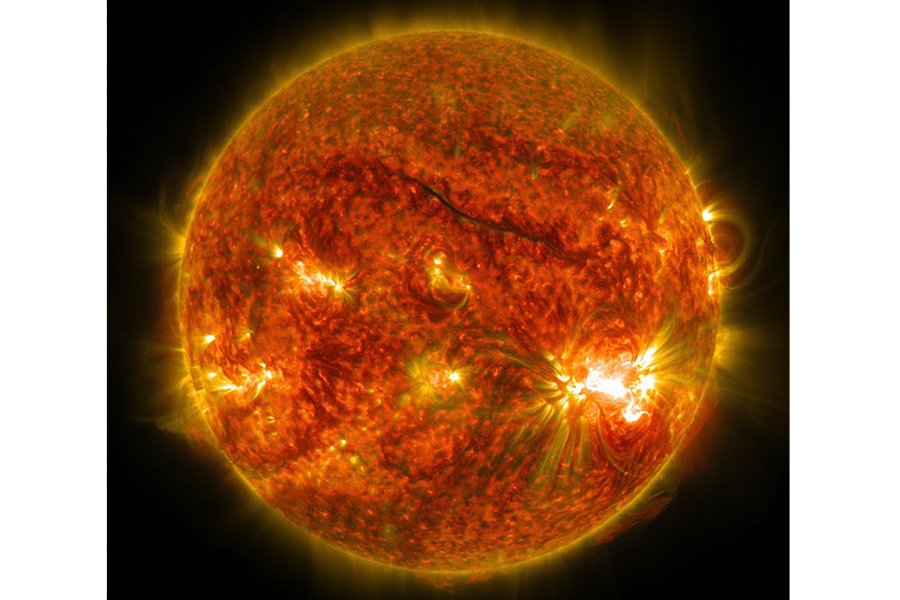Solar flares: Is the sun trying to tell us something?
Loading...
The largest sunspot observed on the sun in more than 20 years has been firing off powerful solar flares for the past week, and it's still producing strong solar storms.
Today, the huge sunspot erupted with a large solar flare, peaking at around 10:47 a.m. EDT (1447 GMT). The flare caused a strong radio blackout on Earth, according to the National Weather Service's Space Weather Prediction Center. This solar flare is the fourth X-flare (the most powerful kind of solar storms) in as many days.
On Sunday (Oct. 26), the giant sunspot unleashed a solar flare, which peaked at about 6:56 a.m. EDT (1056 GMT). The sunspot, called Active Region 12192 (also known as AR 2192), also shot out another powerful flare on Saturday. Today and Sunday's flares measured in at X2, while Saturday's is classified as an X1 flare. [See photos of the largest solar flares of 2014]
Sunday's X2-class flare was "the third X-class flare in 48 hours, erupting from the largest active region seen on the sun in 24 years," NASA spokesperson Karen Fox wrote in an update yesterday (Oct. 26). AR 2129 also shot out an X3.1-class flare on Friday (Oct. 24).
The active region on the sun is also responsible for spewing out two big M-class flares — moderate solar storms — since Friday. The most recent M-class flare (categorized as an M6.7) peaked this morning at about 6:09 a.m. EDT (1009 GMT).
"An X2 is twice as intense as an X1, an X3 is three times as intense, etc.," Fox added.
Sometimes, big solar flares are followed by huge bursts of hot plasma known as coronal mass ejections (CMEs) shooting out from the sun. Large CMEs can cause geomagnetic storms or supercharge Earth's auroras, but according to astronomer Tony Phillips at Spaceweather.com, the earlier storms released by the current sunspot have not had any major accompanying CMEs.
If aimed at Earth, X-class flares can be dangerous for astronauts and spacecraft orbiting the planet. The radiation can disrupt radio and communication signals, but solar flares cannot injure people on Earth's surface, according to Fox. The planet's atmosphere acts as a protective barrier from the harmful radiation.
On Thursday (Oct. 23), skywatchers around North America got a chance to see the sunspot during an amazing partial solar eclipse. Many observers attempting to photograph the cosmic event were able to see the sunspot on the sun's face.
WARNING: Never look directly at the sun through binoculars, a telescope or with your unaided eyes. Serious eye damage and even blindness can result. Scientists and experienced skywatchers use special filters and glasses to safely observe the sun. Do not use regular sunglasses to look at the sun.
Although Friday's X3.1 flare is a powerful solar storm, it isn't the most powerful flare of the year. In February 2014, the sun discharged an X4.9-class tempest.
Editor's Note: If you safely capture an amazing photo of sunspot AR 2129 or any other skywatching sight that you'd like to share for a possible story or image gallery, please contact managing editor Tariq Malik atspacephotos@space.com.
Follow Miriam Kramer @mirikramer and Google+. Follow us @Spacedotcom, Facebook and Google+. Original article on Space.com.
- Anatomy of Sun Storms & Solar Flares (Infographic)
- Attack of the Sun | Video Show
- Solar Quiz: How Well Do You Know Our Sun?
- X-Flare Again! Huge Complex of Sun Storms Not Letting Up | Video
Copyright 2014 SPACE.com, a TechMediaNetwork company. All rights reserved. This material may not be published, broadcast, rewritten or redistributed.







